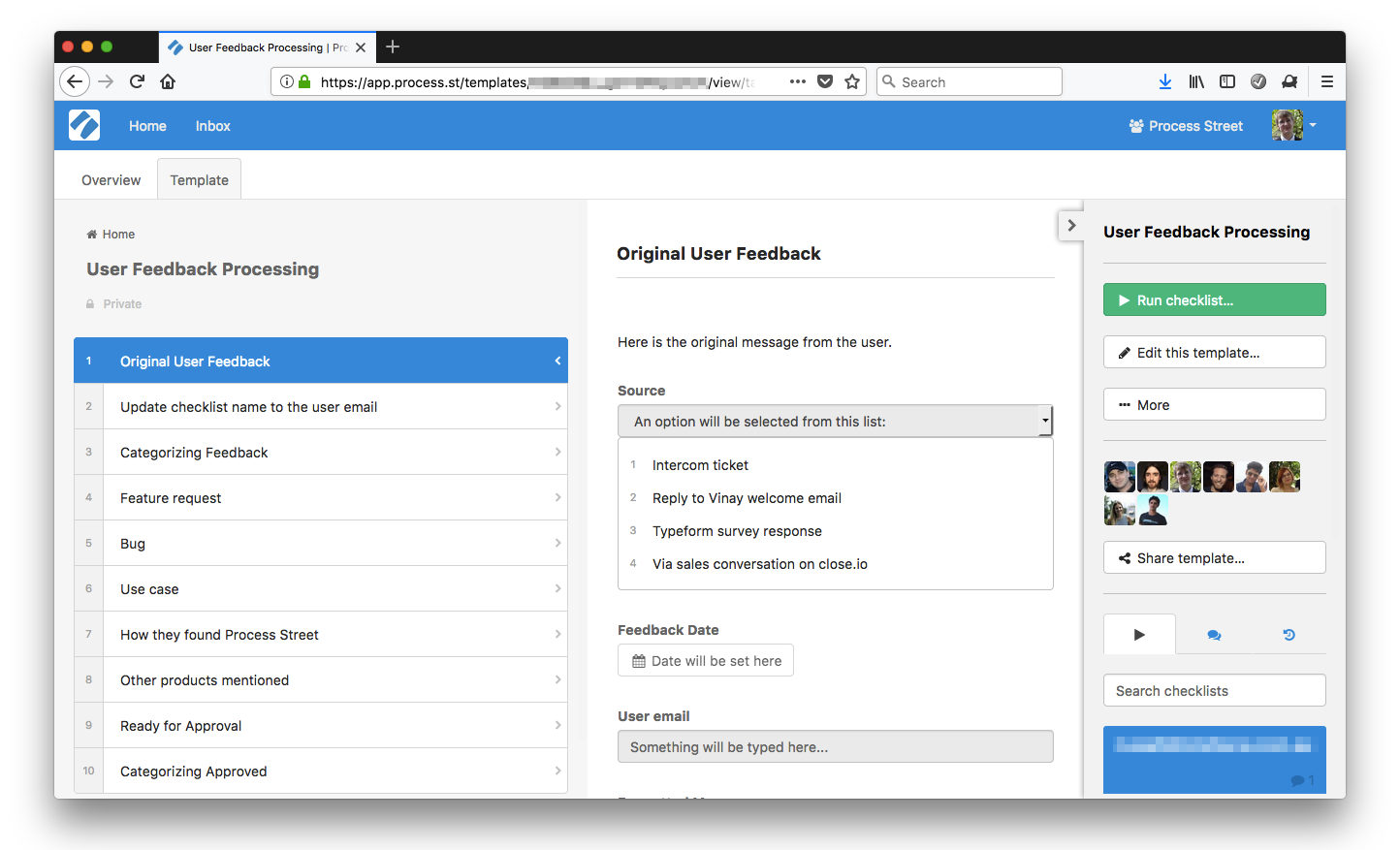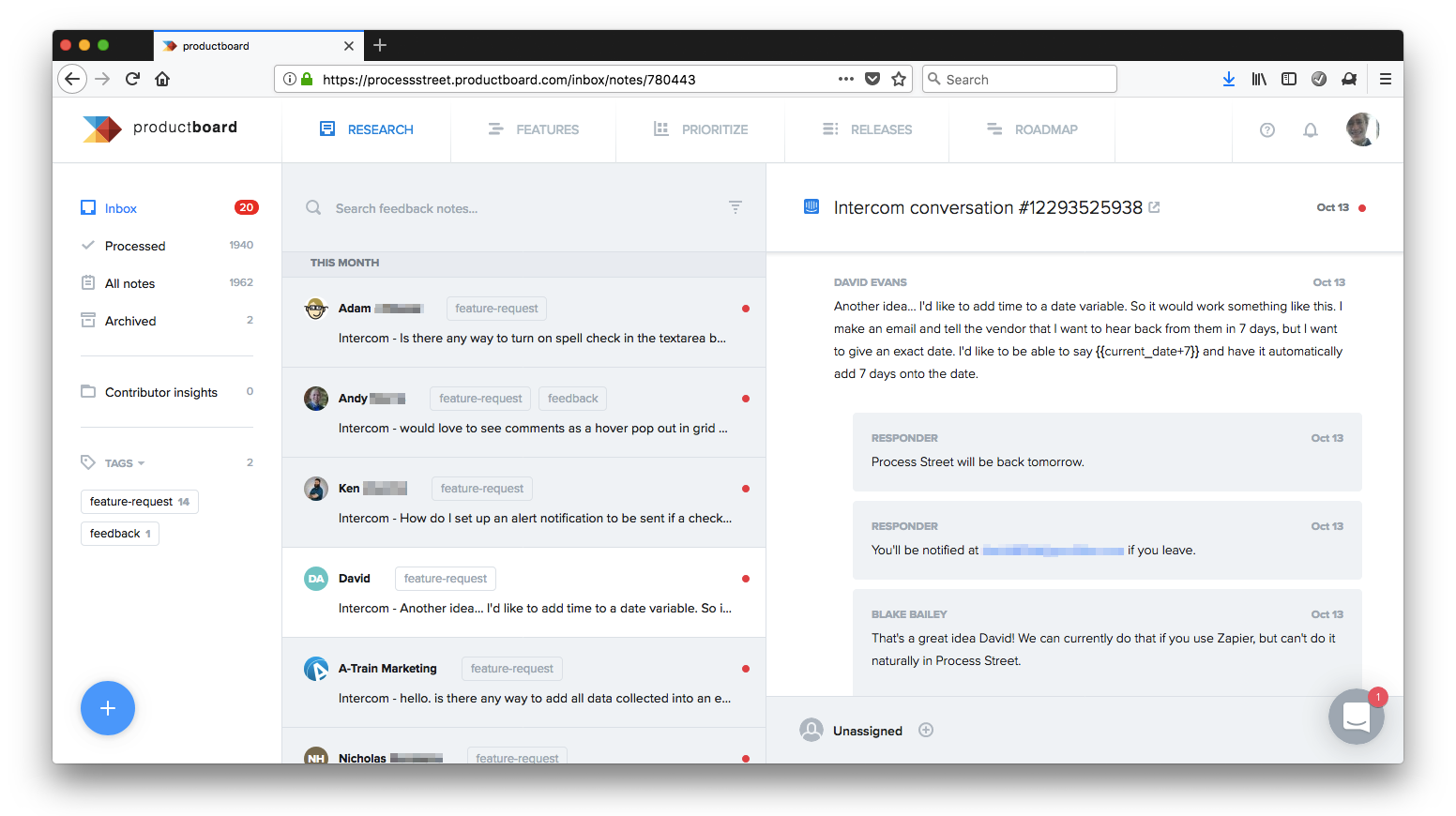
I’ve written before about how we collect feedback on our marketing material and how that helps us write useful posts for our subscribers, but the other reason we gather user feedback focuses on expanding and improving the Process Street app.
With user feedback data, we can:
- Choose which features to build based on the frequency they’re requested
- Get data on bug reports which helps our engineering team build fixes
- See the most common industries and use cases for our product, which guides our marketing in the right direction
Whether you’re in software or not, you still need to be gathering and processing feedback from everybody possible: leads, prospects, free users, and paying customers.
In this post, I’m going to outline the three methods you can use to gather feedback for your company. These are three methods we’ve used ourselves in the past as our business has evolved, so the complexity and usefulness of each method is higher than the last. Which method is right for you?
The manual spreadsheet method
For businesses with a small amount of customers — whether that’s because of a small market and capacity or because the business is new — a spreadsheet is a great choice.
When Process Street had a small number of users and a limited influx of feedback, we manually logged feedback in a spreadsheet. I haven’t been able to dig up the exact sheet, but here’s a template you can use if you decide to go with this method:

Click here to get the spreadsheet template
The sheet might differ depending on your business. Agencies might want to include monthly spend, or the plan the customer pays for. Software companies might opt to add the version of the software the user is giving feedback on. This method is flexible, but it also can be time-consuming when implemented at scale.
Here’s an overview of the process:
- Feedback is found in emails, support tickets, your CRM, Twitter, or anywhere else you get communication from users and leads
- You manually paste the details into the sheet
- Using another column, you tidy and categorize feedback to make it readable and filterable
For a small blog subscriber feedback survey I sent out to our readers earlier in 2017, I used a similar version of this sheet inside Airtable so I could use multi-select fields to quickly categorize user responses.

This is definitely still a manual, ‘dumb’ method, but the tags allow me to filter the records so I can summarize feedback by category. If I want to see the amount of users that say they have no time to create processes, I can just turn a filter on, like shown above.
Let’s weigh out the pros and cons of the spreadsheet method.
Manual spreadsheet method pros
- Free
- Easy to set up
- Easy to train employees to help
- Google Sheets and Airtable allow you to easily share the sheet with your team
- All the traditional power of a spreadsheet (sorting, filtering, formulas)
Manual spreadsheet method cons
- No automation
- Time-consuming at scale
- Data is siloed (not linked to your CRM, support system, or product roadmap)
Best for: small companies with limited amounts of feedback to process.
The semi-automated Process Street method

After we hit a certain feedback volume, manual processing went from being cumbersome to completely unviable.
As we usually do, and since Process Street is such a flexible tool, we started capturing, analyzing, and automating our user feedback with our own software.
Here’s a basic outline of the process:
- Feedback comes in a from variety of sources including a tagged Intercom ticket, a tagged Close.io conversation, or a reply to the Process Street welcome email.
- For each new piece of feedback, Zapier automatically runs a Process Street checklist and pushes the data into form fields. This can be triggered manually by sales or support staff tagging the conversation in Intercom or Close.io, or automatically. All replies to the welcome email count as feedback and get pushed into a checklist.
- Every week, the feedback is processed by hand. The Process Street checklist includes steps and form fields for tidying, categorizing, and submitting feedback for review.
- Each time the last checkbox is checked, Zapier pushes the analyzed feedback to Airtable.
- With this data, we can filter feedback and get structured data on feature requests, bug reports, and use cases.
Here’s the template we use inside Process Street to process user feedback. Feel free to add it to your own organization and edit it to fit your specs.
Users provide feedback in different places: support tickets, sales conversations, and replies to automated emails.
To capture this feedback, we use a mix of manual and automated methods. Support staff manually tag tickets that contain feedback with #user-feedback, and sales staff tag Close.io conversations. These tags trigger a Zapier zap (read more on Zapier here) which pulls the feedback into a Process Street checklist form field. When processed, our feedback is exportable as a CSV or viewable inside Process Street’s Reports feature:

Whether you use a CRM, support system, or online form to gather feedback, you can get the same effect by quickly editing the pre-made zaps below or by making your own.
Process Street method pros
- Automate with 750+ apps via Zapier
- Customizable
- Easy to set up
- Easy to train employees to help
- Form fields for categorizing feedback
- The process lives in the same place as the rest of our processes
- Trackable activity
- CSV export for further data analysis
Process Street method cons
- Time-consuming for companies with a ton of user feedback
- Tickets or conversations that have multiple pieces of feedback are difficult to process elegantly
Best for: agencies with >50 customers, or young startups.
As our feedback volume increased, we found that the system was starting to fall apart when it came to handling more complex needs, like feedback on multiple things (one checklist with categories can’t categorize two things at once). We still run customer analysis inside Process Street because these need just one checklist per customer. For user feedback, however, we’ve switched to productboard.
The productboard method

With an audience of software companies in mind, productboard turned out to be the perfect tool for Process Street to manage user feedback, and associate that feedback with concrete features to build in the app.
Feedback processing is just one part of productboard’s toolkit, but it’s the part that all others survive on. With feedback, you can apply tags and associate the feedback with features and milestones, generating a score that helps you decide which features to build next.

We use productboard’s built-in roadmap so the development, product, marketing, sales, and support teams can be aligned on the plans we have for the future. You don’t have to have a digital product like software to use productboard, either; it’d work just as well for physical products that get a lot of feedback.
However, it would be overkill to implement productboard for pure services companies like agencies. Many of the key features wouldn’t apply because you usually don’t build out a service in the same way you build out a product, and your feedback volume will likely be much lower.
Here’s an overview of the process:
- Feedback comes in via Intercom, Close.io, and user research interviews conducted by Madison, our UX engineer
- Any Close.io or Intercom message tagged #feature-request is added as a feature request in productboard, and interview feedback is added manually
- Tickets tagged #confused in Intercom support are also added to productboard automatically, showing the product team the UX pitfalls in our software
- producboard’s inbox collates all incoming feedback, which is processed manually, piece by piece
- Feedback inside productboard is marked with tags like #pricing-feedback, #bad-ux, #cancellation, etc, so we can get insights into the specific factors and drivers behind our user behavior
- Feedback directly linked to upcoming features is tied to that feature, so we can get a summary of the users’ motivations and use cases and build the feature to match
- Features are collated into a list and scored based on the amount of times they are requested, and the impact they’ll have on our product
- After this stage, productboard is used to track the development and release of the features, and organize them into a roadmap and prioritization chart. This allows the product and development teams to focus their energy on what matters the most
Here’s a shot of our productboard inbox, which shows the incoming feedback before it’s fully processed.

Once processed, we’re able to generate more useful and structured data, like shown here on our feature request list. The list is complete with impact scores which help prioritization.

This feeds into our roadmap. Being able to use the same data for multiple purposes is the beauty of using a system like productboard over a simple spreadsheet.

The productboard method pros
- Seamlessly link feedback with features and a product roadmap
- Automatically push feedback to productboard from a variety of apps (CRM, email, etc.)
- Process feedback collaboratively using an inbox-style interface
- Automate with 750+ apps via Zapier
- Use User Impact scores to get data on how vital a feature will be to your user base
The productboard method cons
- Comparatively expensive (at $49-99/admin/month with 20-50 collaborators)
If you can afford it, your feedback volume is high, and your product is complex enough to warrant it, productboard is definitely the best bet. Otherwise, you’ll be able to get away with using Google Sheets, Airtable, or Process Street.
In this post, we’ve looked at three methods you can use to collate and process user feedback, from a simple sheet to a dedicated solution. Each solution is more complex than the last, but the most complex and fully-featured method isn’t always right for every company. How do you manage your user feedback? Do you have a method to add? Let me know in the comments.







Benjamin Brandall
Benjamin Brandall is a content marketer at Process Street.